北京语言大学外国语言学及应用语言学考博真题导师分数线内部资料
北京语言大学语言学及应用语言学考博真题导师分数线内部资料
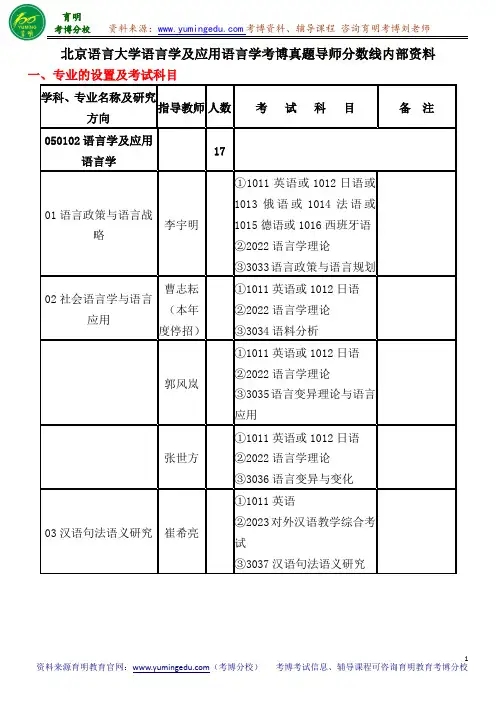
①1011 英语或 1012 日语或 1013 俄 语 或 1014 法 语 或 1015 德语或 1016 西班牙语 ②2022 语言学理论 ③3033 语言政策与语言规划
曹志耘 02 社会语言学与语言
(本年 应用
度停招)
①1011 英语或 1012 日语 ②2022 语言学理论 ③3034 语料分析
09 语言习得与语言病 高立群
理学
※本方向文理
兼收。文科类考 ①1011 英语或 1012 日语
生考 2023 对外 ②2023 对外汉语教学综合考
汉语教学综合 试或 2024 语言逻辑计算机
考试,理工科类 综合考试
考生考 2024 语 ③3043 实验语音学及语音信
言逻辑计算机 息处理
综合考试。①③
6
资料来源育明教育官网:(考博分校) 考博考试信息、辅导课程可咨询育明教育考博分校
育明 考博分校 资料来源: 考博资料、辅导课程 咨询育明考博刘老师
中外博士生“应用视角的语法流派”等。 张博,女,博士,教授。 主要从事古代汉语词汇研究,主要著作为《汉语音转同族词系统性初探》、《简论汉
语同族词的类别及其特征》、《先秦形容词后缀"如、若、尔、然、焉"考察》、《词义的相 应分化与义分同族词系列》、《先秦有四声新证》、《组合同化:词义衍生的一种途径》、《" 动宾结构+宾语"的条件及发展趋势》、《古代汉语词汇研究》等,1993 年获全国普通高等 学校优秀教学成果国家级二等奖。
张黎,男,满族,1963 年生,文学博士,北京语言大学教授,语言学及应用语言学 专业博士生导师,北京语言大学汉语教育研究所所长,商务汉语研究所所长,世界汉语 教学学会会员,中国市场学会营销专家委员会副秘书长,国际商务汉语教学与资源开发 基地(上海)专家委员会委员。
北京外国语大学语料库语言学考博参考书目导师笔记重点
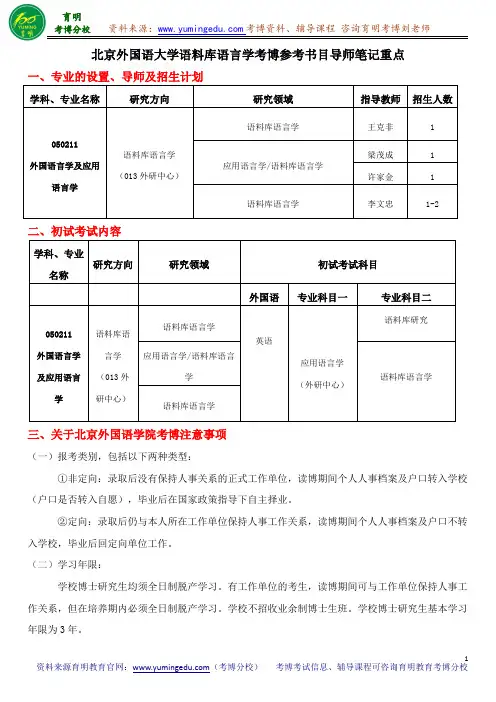
学科、专业 研究方向
名称
研究领域
初试考试科目
外国语 专业科目一
专业科目二
050211
语料库语
语料库语言学
外国语言学
言学 应用语言学/语料库语言
及应用语言 (013 外
学
学
研中心)
语料库语言学
英语
应用语言学 (外研中心)
语料库研究 语料库语言学
三、关于北京外国语学院考博注意事项
(一)报考类别,包括以下两种类型: ①非定向:录取后没有保持人事关系的正式工作单位,读博期间个人人事档案及户口转入学校
第二阶段:专题整理和讲解 在第一阶段的基础上,由专业课老师带领整理重要常考的学科专题,进行各个知识模块的深化和 凝练。以专题为突破口夯实并灵活运用理论知识。 第三阶段:时事热点和出题人的论著 对出题老师的研究重点,最新论文成果和重要的上课的笔记课件进行讲解。对本专业时政热点话 题进行分析,预测有可能出现的题型和考察角度。 第四阶段:历年真题演练和讲解 对历年真题进行最深入的剖析:分析真题来源、真题难度、真题的关联性,总结各题型的解题思 路、答题方法和技巧。全面提升学员的答题能力,把前面几个阶段掌握的理论知识转化为分数。 第五阶段:模拟练习及绝密押题 就最新的理论前沿和学科热点结合现实的热点进行拔高应用性讲解。开展高强度模拟考试,教会 考生怎么破题,怎么安排结构,怎么突出创新点等答题技巧。结合最新的内部出题信息和导师信息进 行高命中押题。
5、经济上要有一定的支撑。包括人际关系费用,找该校的对口复习资料费用,报辅导班的费用, 考试费等等,该花的最好不要省,只要是对考博成功有利的。因为这些钱对于博士生出来后的待遇来 说太微不足道了。 (二)专业课如何复习
对待专业课的认识,有些考生以为自己学了这么多年本专业,甚至发表了不少文章,专业课应该 没问题了,从而放松了对自己专业课复习的要求。其实现在博士录取时,各个环节都不能放松。即使 及格了,如果成绩较低,总分排名靠居后,也会影响导师对自己的印象。提高专业课的复习效率,育 明考博告诉大家可以分为以下两个阶段:
北京外国语大学俄语学院俄语语言文学考博真题导师分数线内部资料
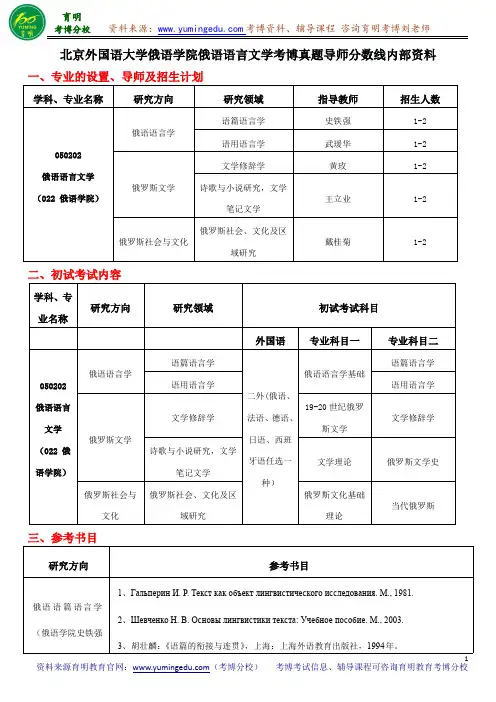
3、胡壮麟:《语篇的衔接与连贯》,上海:上海外语教育出版社,1994 年。
1
资料来源育明教育官网:(考博分校) 考博考试信息、辅导课程可咨询育明教育考博分校
2005 年。
5、乐黛云主编:《比较文学原理新编》,北京:北京大学出版社,2005 年。 1、Березовская Л. Г., Берлякова Н. Р. История русской культуры (в двух частях),
俄罗斯社会与文化 М., 2002.
(俄语学院戴桂菊 2、Дергачев В.А., Вардомский Л.Б. Регионоведение, Москва, 2010.
1、白春仁:《文学修辞学》,吉林:吉林教育出版社,1993 年。
俄罗斯文学:文学 修辞学(俄语学院 黄玫教授)
2、王加兴:《俄罗斯文学修辞特色研究》,北京:北京大学出版社,2004 年。 3 、 Горшков А. И. Лекции по русскபைடு நூலகம்й стилистике. М.: Издательство Литературного института им. А. М. Горького, 2000. 4、符·维·阿格诺索夫主编,凌建侯,黄玫等译,20 世纪俄罗斯文学,中国人
文学修辞学
黄玫
1-2
俄语语言文学
俄罗斯文学
诗歌与小说研究,文学
(022 俄语学院)
王立业
1-2
笔记文学
俄罗斯社会、文化及区 俄罗斯社会与文化
域研究
北外语言学考博试题四
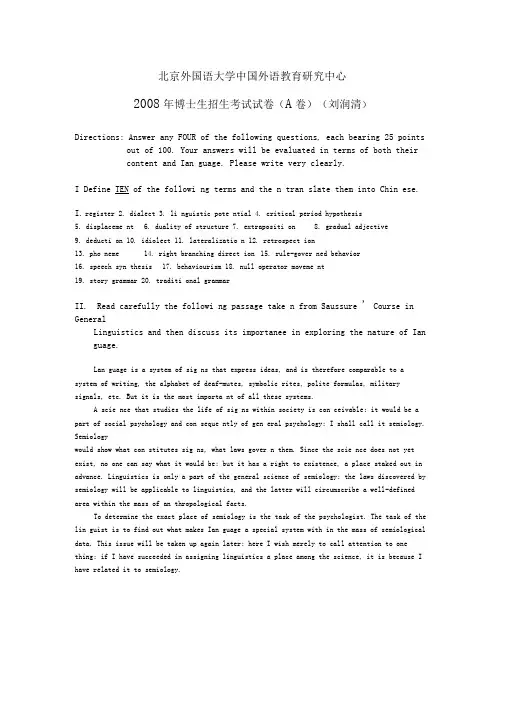
北京外国语大学中国外语教育研究中心2008年博士生招生考试试卷(A卷)(刘润清)Directions: Answer any FOUR of the following questions, each bearing 25 points out of 100. Your answers will be evaluated in terms of both theircontent and Ian guage. Please write very clearly.I Define TEN of the followi ng terms and the n tran slate them into Chin ese.I.register 2. dialect 3. li nguistic pote ntial 4. critical period hypothesis5. displaceme nt6. duality of structure7. extrapositi on8. gradual adjective9. deducti on 10. idiolect 11. lateralizatio n 12. retrospect ion13. pho neme 14. right branching direct ion 15. rule-gover ned behavior16. speech syn thesis 17. behaviourism 18. null operator moveme nt19. story grammar 20. traditi onal grammarII.Read carefully the followi ng passage take n from Saussure ' Course in GeneralLinguistics and then discuss its importanee in exploring the nature of Ian guage.Lan guage is a system of sig ns that express ideas, and is therefore comparable to a system of writing, the alphabet of deaf-mutes, symbolic rites, polite formulas, military signals, etc. But it is the most importa nt of all these systems.A scie nce that studies the life of sig ns within society is con ceivable; it would be a part of social psychology and con seque ntly of gen eral psychology; I shall call it semiology. Semiologywould show what con stitutes sig ns, what laws gover n them. Since the scie nce does not yet exist, no one can say what it would be; but it has a right to existence, a place staked out in advance. Linguistics is only a part of the general science of semiology; the laws discovered by semiology will be applicable to linguistics, and the latter will circumscribe a well-defined area within the mass of an thropological facts.To determine the exact place of semiology is the task of the psychologist. The task of the lin guist is to find out what makes Ian guage a special system with in the mass of semiological data. This issue will be taken up again later; here I wish merely to call attention to one thing: if I have succeeded in assigning linguistics a place among the science, it is because I have related it to semiology.III.The following passage is taken from Halliday ' An Introduction to FunctionalGrammar. Read it carefully, expla in what every sentence mea ns and the n comme nt on his theory of Ian guage.The basic oppositi on, in grammars of the sec ond half of the twen tieth cen tury, is not that betwee n 'structuralist' and 'generative' as set out the public debates of the 1960s.There are manyvariables in the way grammars are written, and any clustering of these is bound to distort the picture; but the more fundamental opposition is between those that are primarily syntagmatic in orientation (by and large the formal grammars, with their roots in logic and philosophy) and those that are primarily paradigmatic (by and large the functional ones, with their roots in rhetoric and ethnography) The former interpret a language as a list of structures, among which, as a distinct second step, regular relationships may be established (hence the introduction of transformations); they tend to emphasize universal features of language, to take grammar (which they call syntax) as the foundation of language (hence the grammar is arbitrary), and so to be organized around the sentence. The later interpret a language as a network of relations, with structurescoming in as the realization of these relationships; they tend to emphasize variables among differentlanguages, to take semantics as the foundation (hence the grammar is natural) and so to be organized around the text, or discourse, There are many cross-currents, with insights borrowed from one to the other; but they are ideologically fairly different and it is often difficult to maintain a dialogue.IV.The following passage is take from Peter Barb's Word Play: What Happens When People Talk (1973). Read it carefully and then comment on linguistic relativity.Such a connection between language and thought is rooted in common-sense beliefs, but no one gave much attention to the matter before Wilhelm von Humboldt, the 19th century German philologist and diplomat. He statedthat the structure of a language expresses the inner life of its speakers: "Man lives with the world abut him, principally, indeed exclusively, as language presents it." In this century, the case for a close relationship between language and reality was stated by Edward Sapir: "Human beings d not live in the objective world alone, nor alone in the world of social activity as ordinarily understood, but are very much at the mercy of the particular Ianguage which has become the medium for their society. The fact of the matter is that the 'real world' is to a large extent built up on the language habits of the group. No two languages are ever sufficiently similar to be considered as representing the same social reality. The worlds in which different societies live are distinct worlds, not merely the same world with different labels attached."About 1932 one of Sapir's students at Yale, Benjamin Lee Whorf, drew on Sapir's ideas and began an intensive study of the language of the Hopi Indians of Arizona. Whorf's brilliant analysis of Hopi places common-sense beliefs about language and thought on a scientific basis -- and it also seemed to support the view that man is a prisoner of his language. Whorf concluded that language "is not merely a reproducing instrument for voicing ideas but rather is itself the shaper of ideas. … we dissect nature along lines laid down by ourartive Ianguages."V.Please give the main content of Grice's Cooperative Principle with its four maxims explained and then discuss conversational implicatures of Group A (in which no maxim is violated), Group B (in which a maxim is violated), and Group C (in which a maxim is flouted by means ofa figure of speech).VI.The following is a passage by Chomsky. Read it carefully and then discuss th e difference between Chomsky's theory of linguistics and other approaches in linguistics.Generative grammar arose in the context of what is often called “the cognitive revolutionthe 1950s, and was an important factor in its development. Whether or not the term“ revol uappropriate, there was an important change of perspective: from the study of behavior and its products (such as texts), to the inner mechanisms that enter into thought and action. The cognitive perspective regards behavior and its products not as the object of inquiry, but as data that may provide evidence about the inner mechanisms of mind and the ways these mechanisms operate in executing actions and interpreting experience. The properties and patterns that were the focus of attention in structural linguistics find their place, but as phenomena to be explained along with innumerable others, in terms of the inner mechanisms that generate expressions. The approach is“ mentalistic, ” but in what should be an uncontroversial sense. It is concerned with “m of the world, ”which stand alongside its mechanical, chemical, optical, and other aspects. It undertakes to study a real object in the natural world —the brain, its states, and its functions —and thus to move the study of the mind toward eventual integration with the biological science.(Chomsky, N. 2000. New Horizons in the Study of Language and Mind)VII.The following is taken from Bloomfield's Language about the famous story of Jack and Jill which is often quoted to illustrate Bloomfield's behaviorism inlinguistics. Read it carefully and discuss how Bloomfield explains the process of stimulus and response and point out where he is wrong.Suppose that Jack and Jill are walking down a lane. Jill is hungry. She sees an apple in a tree. She makes a noise with her larynx, tongue and lips. Jack vaults the fence, climbs the tree, take the apple, brings it to Jill, and places it in her hand. Jill eats the apple.This succession of events could be studies in many ways, but we, who are studying language, will naturally distinguish between the act of speech and the other occurrences, which we shall call practical events . Viewed in this way, the incident consists of three parts in order of time:A.Practical events preceding the act of speech.B.Speech.C.Practical events following the act of speech.We shall examine first the practical events: A and C. The events in A concern mainly the speaker, Jill. She was hungry; that is, some of her muscles were contracting, and some fluids were being secreted, especially in her stomach. Perhaps she was also thirsty; her tongue and throat were dry. The light-waves reflected from the red apple struck her eyes. She saw Jack by her side. Her past dealings with Jack should now enter into the picture; ket us suppose that they consisted in some ordinary relation, like that of brother and sister or that of husband and wife. All these events, which precede Jill's speech and concern her, we call the speaker's stimulus.We now turn to C, the practical events which came after Jill's speech. These concern mainly the hearer, Jack, and consist of his fetching the apple and giving it to Jill. The practical events which follow the speech and concern the hearer, we call the hearer's response. The events which follow the speech concern also Jill, and this in very important way: she gets the apple into hergrasp and eats it.。
北京语言大学比较文学与世界文学考博真题导师分数线内部资料
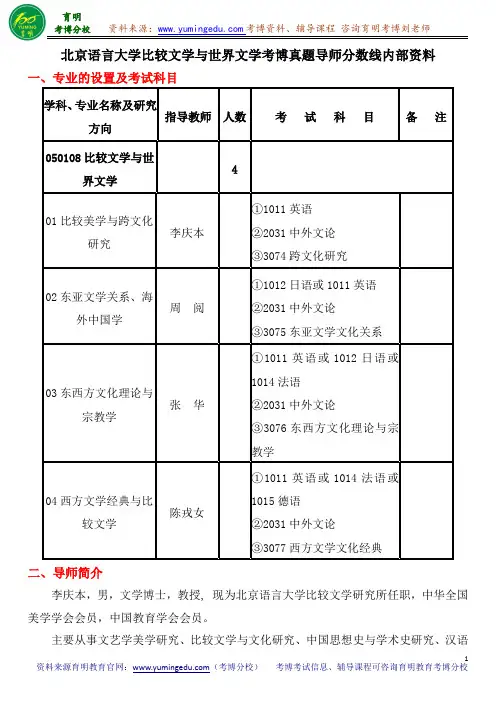
04 西方文学经典与比 陈戎女
较文学
① 1011 英 语 或 1014 法 语 或 1015 德语 ②2031 中外文论 ③3077 西方文学文化经典
二、导师简介
李庆本,男,文学博士,教授, 现为北京语言大学比较文学研究所任职,中华全国
美学学会会员,中国教育学会会员。
主要从事文艺学美学研究、比较文学与文化研究、中国思想史与学术史研究、汉语
陈戎女,女,1999 年至今执教于北京语言大学,比较文学与世界文学专业硕士生导 师,中国比较文学学会会员,承担多项海外和国内教育部的科研项目。
主要研究方向有以德国思想家西美尔(Georg Simmel)为主题的文化社会思想研究, 代表作为专著《西美尔与现代性》(上海书店出版社,2006),译著《货币哲学》(合译, 华夏出版社,2002),及论文《西美尔文化-现代性理论述评》(《学术研究》,2000),《“时 髦”的西美尔?》(《二十一世纪》,2001),《宗教的现代样式与功能》(《道风基督教文
②两门专业课 育明教育考博分校解析:对于这两门专业课,大家应该找对参考书目、找好资料、 加上合理的规划和到位的辅导,考博成功是没有问题的。 ③同等学力考生初试加试政治(马列哲学),复试加试两门硕士阶段主干课程。 育明教育考博分校解析:同等学力的考生考博确实有一定的难度,但是每一年都有 成功的例子。只要大家肯努力,把资料准备齐全,然后给自己制定一个合理的规划,再 找人给自己做一个到位的辅导,相信考取北京语言大学的博士并不是不可能的事情。 (2)第二阶段综合考试:面试。 育明教育考博分校解析:复试情况要看具体院系的具体安排,面试一般是不可避免 的,除理工类专业之外,一般综合考试不再设立专业笔试。综合考试都要考虑身心健康 状况、思想政治状况、培养潜质、就业因素等,全面、慎重地权衡考生面试成绩。 3、学校初试复试(面试)基本分数线要求
北京外国语大学外国语言学及应用语言学—语料库语言学(外研中心)考博招生介绍—考试内容—考试指南
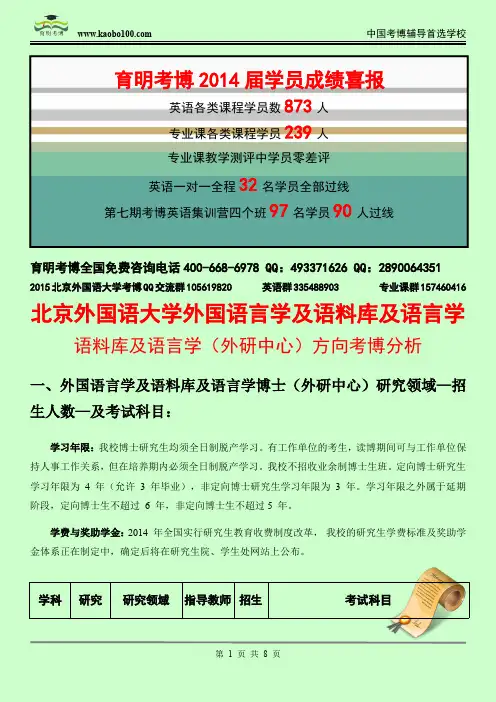
第2页共8页
中国考博辅导首选学校
北京外国语大学中国外语教育研究中心专职研究员、教授、博士生导 2005 年 9 月至 2008
所选课程为考博英语特别保录班与专业课定向保录班。经过近三个月高强度
的辅导学习,顺利考入中科院数学院就所。
学员四、
张广超:中国矿业大学大学资源与安全工程学院博士
简介:育明考博 14 届优秀学员,硕士毕业于中国矿业大学资源与安全工程
学院。2013 年 12 月份进入育明考博辅导课程,所选课程为考博英语一对一。
开课时间 A 班:8月21日-25日 B 班:9月12日-17日 A 班 : 10 月 3 日 -7 日 B 班 : 11 月 7 日 -11 日 C 班:12月12日-16日 A 班:2月20日-22日 B 班:3月6日-8日
课时 40课时授课+12课时练习 40课时授课+12课时练习 24课时授课+8课时模考
年 4 月,北京外国语大学中国外语教育研究中心,博士后研究员;2005 年 5 月毕业于
南京大学外国语学院,获应用语言学博士学位;2000 年 6 月毕业于徐州师范大学语言
研究所,获对比语言学硕士学位;1987 年 6 月至 1997 年 8 月,任教于徐州师范大学外
国语学院。
李文中:北京外国语大学中国外语教育研究中心教授、博士生导师。研究兴趣:
大学 RDUES 访问研究员。
三、注意事项:
考试:
公开招考方式包括初试和复试两个环节。
(一)初试
初试科目为三门,包括第二外国语(非外语专业为公共外语)和两门专业考试。每门科目的考 试时间为 3 小时,满分 100 分。由我校自行命题,考试形式均为笔试。
北京师范大学外国语言文学学院应用语言学考博真题-参考书-分数线-分析资料-复习方法-育明考博
北京师范大学外国语言文学学院应用语言学考博指导与分析一、北京师范大学外国语言文学学院考博资讯北京师范大学外国语言文学学院的课程与教学论专业初试的两门专业课均用英文答题其余的见下文。
(一)考试科目及各方向导师:5.050211外国语言学及应用语言学研究方向01:应用语言学。
导师是罗少茜。
考试的科目:(1)1113二外(日语)或1114二外(法语)(100%)。
(2)2018普通语言学(100%)。
(3)3103应用语言学(100%)。
(二)复试分数线:1.复试原则与分数线:此分数线是各专业的最低复试/录取分数要求。
只适用于报考普通博士生、高校辅导员在职攻读思想政治教育专业博士学位研究生、高校思想政治理论课教师在职攻读马克思主义理论博士学位研究生的考生,不适用于少数民族高层次骨干人才攻读博士学位研究生和对口支援西部地区高等学校定向培养博士学位研究生。
未组织复试的导师,将在此分数线基础上,按照一定比例确定复试名单,并在4月中旬前组织复试,具体复试名单由报考院系通过院系网站或电话告知。
已经复试的导师,将在此分数线基础上,依据录取规则,按顺序录取。
专业代码及名称外国语业务课一业务课二总分050211外国语言学及应506060180用语言学2.复试方案:复试将对考生科研及实践经验、学术潜力、实践能力、综合素质等进行全面考查。
复试形式为面试,考生需参加两个小组的面试。
实践组(复试一组):重点考察考生实践经验及实践能力、实践案例分析。
考生进场后,自我陈述3分钟左右,然后回答案例问题,考官提问。
科研组(复试二组):重点考察考生科研经验及科研能力、研究选题计划、综合素质。
考生进场后,陈述研究选题计划3分钟后,考官提问。
复试满分值为200分,每小组满分各为100分。
每小组及格分为60分,一组或两组成绩不及格者不予录取。
每小组由5位复试教师组成。
考生在每个小组的复试成绩,为该组考官所给的5个成绩按照“去掉一个最高分、去掉一个最低分、其余分数加总再除以3”的方法得出。
2013年北京外国语大学中国外语教育研究中心外国语言学及应用语言学真题及详解【圣才出品】
2013年北京外国语大学中国外语教育研究中心外国语言学及应用语言学真题及详解I. Briefly explain the following terms. (50 points, 5 points each)1. affix【答案】An affix refers to the collective term for the type of morpheme that can be used only when added to another morpheme (the root or the stem), which has three subtypes: prefix, such as un-, mini-, para-; suffix, -ish, -al, -tion; and infix, abso-bloomingly-lutely, un-fucking-believable. All the affixes are the bound morphemes.The affixes that attach to verbs and do not change the category are usually inflectional affixes. For example, -s in reads, looks and listens; -ed in excited, interested and consisted; -ing in studying, making and sitting. They are just grammatical markers and do not change the category of words.2. inflection【答案】Inflection is the manifestation of grammatical relationship through the addition of inflectional affixes, such as number, person, finiteness, aspect and case, which do not change the grammatical class of the stems to which they are attached. For example, the past form of the verb work is realized by the addition of the inflectional suffix: “-ed”; the plural form of the noun child is realized by theinflectional suffix: “-ren”.3. mood【答案】The mood is the variation in the conjugation of a verb to express the manner or form. It includes three types, namely, imperative mood, indicative mood and subjunctive mood.4. modality【答案】In linguistics, modality is what allows speakers to attach expressions of belief, attitude and obligation to statements. In standard formal approaches to modality, an utterance expressing modality can always roughly be paraphrased to fit the template.5. interlanguage【答案】Interlanguage refers to the type of language constructed by second or foreign language learners who are still in the process of learning a language. It’s a language system between the target language and the learner’s native language, and imperfect compared with the target language, but not mere translation from the learner’s native language. For example, when a Chinese student is learning English, he may make errors like “to touch the society”.6. language transfer【答案】Native language plays an important role in the process of second language acquisition. When the native language influences the acquisition of the target language, language transfer happens. For example, the students’learned knowledge and skills in the native language can be transferred to the second language. When the two languages are similar in structure, then the native language facilitates the target language learning, and we call it a positive transfer; when the two languages are different in structure, then the native language interferes with the target language learning, and we call it a negative transfer.7. speech act【答案】Speech act is a central concept in Speech Act Theory, according to which, we are performing various kinds of acts when we are speaking. Actions performed through utterances are generally called speech acts.8. verbal behavior【答案】The verbal behavior is the behavior under the control of consequences mediated by other people (who can interchangeably function as speaker and listener)-was best understood in a functional analysis.9. co-operative principles【答案】The four maxims of the co-operative principle are as follows:Quantity. (1) Make your contribution as informative as is required (for the current purposes of the exchange). (2) Do not make your contribution more informative than is required.Quality. Try to make your contribution one that is true. (1) Do not say what you believe to be false. (2) Do not say that for which you lack adequate evidence.Relation. Be relevant.Manner. Be perspicuous. (1) Avoid obscurity of expression. (2) Avoid ambiguity.(3) Be brief. (4) Be orderly.In the utterance given, it is probable that the speaker is particularly careful about the maxim of Quality, which rules that do not say that for which you lack adequate evidence.10. vernacular【答案】A vernacular is the native language or native dialect of a specific population, as opposed to a language of wider communication that is a second language or foreign language to the population, such as a national language, standard language, or lingua franca.II. Read the following passage and then answer questions. (40 points)1. What does “French made me absent the way he was absent” (1.6-7) mean?(5 points)2. What is “a French immersion summer programme” (1, 8)? (5 points)3. What are formative experiences (1.9)? (5 points)4. What is “a French-medium school” (1.9-10)? (5 points)5. What does Kaplan mean when she says “there was a French beyond the everyday” (1. 13-14)? (5 points)6. What does “the new community and culture” (1.15-16) refer to? What ismeant by “a complete self-identification” (1.15) with it? (5 points)7. What does Kaplan’s success story illustrate? (10 points)【答案】1. Learning French is connected with her father. Although her father has passedaway, she could always feel him when studying French.2. Kaplan fully devoted herself for a whole summer to learning French.3. One is to study a year abroad in a French-medium school in Switzerland atthe age of 15 in high school; the other is an academic year abroad in Bordeaux three years later, while she was a French literature undergraduate.4. In Switzerland, French is a connected language for students when they are learning.5. She was always as intense for French culture as it was for the French language. She felt French was everywhere and French could express her bottom of heart.6. “The new community and culture” refers to the sphere of Frenchknowledge, French culture, French thinking patterns, etc. She found French was her part of body, at that time she finally felt that she was complete and she knew what she was.7. ①The interests are very important during the process of study.②Work hard, think actively and innovatively.(答案仅供参考,考生只要言之成理即可酌情给分。
2021北京语言大学外国语言学及应用语言学考研真题经验参考书
下面我分科来介绍:1. 政治肖大大的书是肯定要买的,肖大大出的书我都买了。
因为我是理科生,所以,我配着徐涛的视频看肖大大的精讲精练,把重点画下来,然后做1000题。
我把1000题做了四遍左右,第一遍我是看完视频和书做题,错了就会在书上把知识点画下来,把错的题也标下来,后面再做不会再看书了,每一遍都把错题标出来,最后一遍就做高频题和易错题。
因为我感觉今年肖大大的四套卷和八套卷的选择题过于简单,可以最后再找一下别的老师的卷子练一下。
当然我的政治考得不是很好,建议学弟学妹们可以看看70+的大神们的政治经验贴。
2. 日语今年我的初试分考的不是很好,主要就是日语拉分,因为今年的日语也就初级上的难度,但是我的重点主要放在初级下,所以导致我才考了74。
考北语的同学很多今年都考了90+,至少也都80+,所以学弟学妹们一定要好好重视日语,北语的日语一般不出很难,重点就是初级上下两册,我准备初试的时候,没有练很多题,学弟学妹们如果想考北语可以做一下N3的练习题或者二外日语真题及强化练习题详解(名字就是这个)。
还有一定要早练作文,虽然二外的题型每年都不固定,但是练了肯定没有坏处。
北语去年和今年的日语都过于简单,也不排除明年会加大难度。
(如果觉得自己日语基础不是很好的话,建议报个一对一辅导班,听之前的学姐说,新祥旭一对一辅导班还是非常不错的)。
3. 基础英语北语的基础英语主要考单选,阅读,翻译(英汉,汉英都有),写作,而且难度一直很大我的建议是可以买一份娜姐的资料,她的资料里有十年的真题(语言学+基础英语),单选,阅读,翻译的练习题,真题很重要,有了真题你就会知道北语的侧重点是什么,主要考什么知识点,当然基础英语主要是练。
我每天都会做阅读,20个单选,翻译坚持每天练,汉译英和英译汉各一段,我用的书是散文108篇,我还想提一个笨方法,我背过108篇里的很多文章,匆匆,盼头,野草,论读书等等,我觉得背文章可以让我记住一些表达,但是一定要在以后练翻译的时候尽力用上,这样好的表达才可以变成你自己的。
北京大学语言学及应用语言学专业考博真题考试内容专业课一本通资.
北京大学语言学及应用语言学专业考博考试内容考试重点备考指导一、北京大学中文系博士招生人数及报考统计年份招生方式及人数公开招考报名人数报录比复试分数线2013年公开招考(44人256人6:1外语>=45专业课>=60(2015年2014年公开招考(43人244人6:12015年公开招考(38人176人4:1育明考博辅导中心张老师解析:1、北大中文系共有8个博士招生专业:文艺学、语言学及应用语言学、汉语言文字学、中国古典文献学、中国古代文学、中国现当代文学、比较文学与世界文学、中国语言文学(中国民间文学,各专业之间报录比差别还是比较大的。
2、2016年北京大学中文系内地计划招生人数为38人。
3、北大中文系考博历年缺考率平均在30%左右。
(北京大学中文系考博资料获取、课程咨询育明教育张老师叩叩:七七二六、七八、五三七二、北大中文系语言学及应用语言学专业考博考试内容分析(育明考博辅导中心专业招生人数初审复审内容050102语言学及应用语言学2013年1人2014年5人2015年3人申请—考核制1、学术水平的考查:笔试(100分:语言学专业及基础面试(100分2、思想政治素质和品德的考核:政治态度、思想表现、学习(工作态度,道德品质、遵纪守法等方面。
育明考博辅导中心张老师解析:1、北京大学中文系语言学及应用语言学专业考博的报录比平均在6:1左右(竞争较激烈。
2、本专业有2个研究方向:01.理论语言学(含对外汉语教学02.语音学。
3、同等学力申请者加试政治课(哲学。
4、2016年北京大学实行“申请—考核制”,没有提供雅思、托福等英语成绩等级证明的同学,需要参加“北京大学博士研究生英语水平考试”;俄语、日语、法语、德语要求:北京大学组织的博士生外语考试过及格线。
外语考试后中文系根据研究生院提供的建议分数线确定外语及格线。
掌握少数民族语言的少数民族申请者的外语成绩要求可适当降低。
5、复试总成绩计算方法:外语成绩20%+学科笔试成绩30%+面试成绩50%。
- 1、下载文档前请自行甄别文档内容的完整性,平台不提供额外的编辑、内容补充、找答案等附加服务。
- 2、"仅部分预览"的文档,不可在线预览部分如存在完整性等问题,可反馈申请退款(可完整预览的文档不适用该条件!)。
- 3、如文档侵犯您的权益,请联系客服反馈,我们会尽快为您处理(人工客服工作时间:9:00-18:30)。
北京语言大学外国语言学及应用语言学考博真题导师分数线内部资料一、专业的设置及考试科目学科、专业名称及研究方向指导教师人数考试科目备注050211外国语言学及应用语言学401句法学黄正德(本年度停招)①1022二外日语或1024二外法语或1025二外德语②2039理论语言学③3086句法学司富珍①1022二外日语或1023二外俄语或1024二外法语或1025二外德语②2039理论语言学③3086句法学02语义学(语用学)吴平①1022二外日语或1023二外俄语或1024二外法语或1025二外德语或1026二外西班牙语②2039理论语言学③3087语义—语用理论研究03英汉语言对比研究高明乐①1022二外日语或1023二外俄语或1024二外法语或1025二外德语或1026二外西班牙语②2039理论语言学③3088英汉语言对比研究二、导师简介司富珍,女,北京语言大学语言学及应用语言学专业文学博士,美国麻省理工学院语言学和哲学系博士后访问学者,现任北京语言大学外国语言学及应用语言学专业教授、博士生导师。
主要研究兴趣为理论语言学,涉及的主要领域有形式句法研究、乔姆斯基的语言学和哲学思想研究、语言理据研究、突厥语族语言功能中心语研究、语言学研究方法等。
已经出版著作四部,主编和参编语言学论文集和志书等多部,在国内外重要学术期刊和大型国际国内学术会议发表论文数十篇。
吴平,男,浙江慈溪人,北京语言大学外国语学院教授,博士研究生导师,教育部“新世纪优秀人才支持计划”入选者(2009年),教育部留学回国人员科研启动基金评审专家,美国富布赖特高级驻校学者(2012年)。
学术研究领域是语言学及应用语言学专业理论语言学方向。
现阶段主要从事基于形式化分析的句法-语义接口问题研究。
代表性专著《句式语义的形式分析与计算》(2007年)荣获教育部高校科学研究优秀成果奖(人文社会科学)三等奖(2009年)和第一届中国大学出版社图书奖优秀学术著作奖二等奖(2010年),已在CSSCI 来源期刊上发表学术论文30余篇,已主持完成或正在主持国家社科基金一般项目1项、教育部各类项目3项和国家社科基金重大项目子课题1项。
此外,近年来多次承担国家社科基金一般项目结项成果、国家社科基金后期资助项目、教育部人文社科基金项目申报,以及国家留学基金委资助申报的评审专家工作。
高明乐,文学博士,教授,博士生导师。
现为北京语言大学英语教育中心主任,北04句法语义理论潘海华①1022二外日语或1023二外俄语或1024二外法语或1025二外德语或1026二外西班牙语②2039理论语言学③3089句法语义理论京语言大学理论语言学研究中心执行主任;兼任全国外语院校大学外语教学协会副会长,中国语言教育研究会常务理事,北京市大学英语研究会理事,美国MLA会员。
主要研究方向:理论语言学、应用语言学、中英语言文化比较研究等。
主要成果:主持国家社科基金中华学术外译项目一项,主持教育部哲学社会科学研究后期资助项目一项,主持北京市教改项目一项;已出版专著一部,编著2部,译著4部;发表论文30余篇。
潘海华,男,博士学位,香港城市大学中文、翻译及语言学系博士生导师,上海师范大学语言研究所兼职研究员,华中科技大学中文系及湖南大学语言学系客座教授,兼任《当代语言学》、《现代外语》、《Language Research》(韩国)编委。
目前为止潘海华博士已出版专著《形式语义学引论》(合著,中国社会科学出版社,1998/2004),并编辑出版《汉语语言学研究(二)》(Studies in Chinese Linguistics II)(香港语言学学会,2001)及《焦点的结构与语义解释》(合编,北京外语教学与研究出版社,2004),发表研究论文40余篇,匿名评审论文30余篇。
先后在德国、澳大利亚、中国大陆及香港作应邀讲座三十余场。
其研究范围涵盖句法理论、形式语义学、语料库语言学、计算语言学、机器翻译、人工智能等诸多领域。
三、参考书目专业课信息应当包括一下几方面的内容:第一,关于参考书和资料的使用。
这一点考生可以咨询往届的博士学长,也可以和育明教育考博分校(官网可咨询)联系。
参考书是理论知识建立所需的载体,如何从参考书抓取核心书目,从核心书目中遴选出重点章节常考的考点,如何高效的研读参考书、建立参考书框架,如何灵活运用参考书中的知识内容来答题,是考生复习的第一阶段最需完成的任务。
另外,考博资料获取、复习经验可咨询叩叩:柒伍陆壹,伍贰玖,叁伍,专业知识的来源也不能局限于对参考书的研读,整个的备考当中考生还需要阅读大量的paper,读哪一些、怎么去读、读完之后应该怎么做,这些也会直接影响到考生的分数。
第二,专题信息汇总整理。
每一位考生在复习专业课的最后阶段都应当进行专题总结,专题的来源一方面是度历年真题考点的针对性遴选,另一方面是导师研究课题。
最后一方面是专业前沿问题。
每一个专题都应当建立详尽的知识体系,做到专题知识点全覆盖。
第三,专业真题及解析。
专业课的试题都是论述题,答案的开放性比较强。
一般每门专业课都有有三道大题,考试时间各3小时,一般会有十几页答题纸。
考生在专业课复习中仅仅有真题是不够的,还需要配合对真题最权威最正统的解析,两相印证才能够把握导师出题的重点、范围以及更加偏重哪一类的答案。
第四,导师的信息。
导师的著作、研究方向、研究课题、近期发表的论文及研究成果,另外就是为研究生们上课所用的课件笔记和讨论的话题。
这些都有可能成为初复试出题的考察重点。
同时这些信息也是我们选择导师的时候的参照依据,当然选择导师是一个综合性的问题,还应当考虑到导师的研究水平、课题能力、对待学生的态度和福利等等。
第五,时事热点话题分析。
博士生导师在选择博士的时候会一般都会偏重考查考生运用基础理论知识来解决现实热点问题的能力,这一点在初试和复试中都有体现。
近几年的真题中都会有联系实际的热点分析。
所以考生在复习备考时就应单多阅读一些本专业本学科的最新研究方向研究成果,权威的期刊上面“大牛们”都在关心、探讨什么话题,以及一些时事热点问题能不能运用本专业的知识来加以解释解决。
四、北京语言大学考博英语复习指导北京语言大学的考博英语满分100分,题型有20题20分的词汇,10分的完形填空,5篇40分的阅读理解,15分的英译汉翻译,15分的作文。
北京语言大学考博英语的整体难度介于六级和老托福之间,对词汇量有很高的要求,特别注重对形近字、意近词和固定搭配以及语法的考察。
做阅读理解一定要遵守“实事求是”的原则,翻译这一个题型很容易丢分,要想得高分,每一天都要遵循“八步法”练习三个句子。
作文对于考生的英语综合能力要求很高,要做到“厚重、灵动和美观”,复习资料建议使用育明教育考博分校编写的北京语言大学考博英语一本通。
每年有大批的同学英语单科受限,对于英语基础比较差的考生,建议大家早做准备。
(北京语言大学考博资料获取、辅导课程可咨询叩叩:柒伍陆壹,伍贰玖,叁伍)育明教育考博分校专注于北京地区高校的考博英语及专业课课程辅导。
根植育明学校深厚的高校资源,整合利用历届育明优秀学员的成功经验与高分资料,为每一位学员构建考研考博成功的基础保障,辅导学员人数及辅导成绩连续多年稳居第一。
针对北京语言大学各专业的考博开设的辅导课程包括:考博英语课程班、考博专业课课程班、申请制课程班、高端协议班。
历年考博课程班的通过率均超过80%。
五、北京语言大学考博专业课复习指导以下是育明教育考博课程的授课规划,整个授课规划由本专业博士生和组织设定,结合了考试命题的实际,借鉴了历届育明成功学员的复习计划和成功经验,是育明教育考博课程授课质量的保证和高录取率的基础。
考生们也可以借鉴这一复习规划来指导自己的备考。
第一阶段:框架的构建和重点的掌握深入解构核心参考书,建立知识理论体系框架并对重点知识章节和常见考点进行整合。
理清楚学科发展史,特别是每一个阶段的代表人物,著作,主张,提出的背景和评价。
根据专业课老师讲解借鉴前辈经验最终形成学员的专属笔记。
第二阶段:专题整理和讲解在第一阶段的基础上,由专业课老师带领整理重要常考的学科专题,进行各个知识模块的深化和凝练。
以专题为突破口夯实并灵活运用理论知识。
第三阶段:时事热点和出题人的论著对出题老师的研究重点,最新论文成果和重要的上课的笔记课件进行讲解。
对本专业时政热点话题进行分析,预测有可能出现的题型和考察角度。
第四阶段:历年真题演练和讲解对历年真题进行最深入的剖析:分析真题来源、真题难度、真题的关联性,总结各题型的解题思路、答题方法和技巧。
全面提升学员的答题能力,把前面几个阶段掌握的理论知识转化为分数。
第五阶段:模拟练习及绝密押题就最新的理论前沿和学科热点结合现实的热点进行拔高应用性讲解。
开展高强度模拟考试,教会考生怎么破题,怎么安排结构,怎么突出创新点等答题技巧。
结合最新的内部出题信息和导师信息进行高命中押题。
(北京语言大学考博资料获取、辅导课程可咨询叩叩:柒伍陆壹,伍贰玖,叁伍)六、北京语言大学考博特别注意事项1、关于招生时间北京语言大学每年在中国内地招收博士生统考有一次,为春季招生。
初试时间一般为3月中下旬,复试(面试)时间:报考人数12人以下(含)的专业,初试完成后次日进行复试(面试),其他专业复试(面试)时间另行通知。
同等学力考生初试加试政治(马列哲学),复试加试两门硕士阶段主干课程。
2、关于考试科目(1)第一阶段笔试:①基础外语:英语、德语、日语、法语等,自己选一门或按照报考老师要求选一门。
育明教育考博分校解析:北京语言大学的考博英语难度介于六级和老托福之间,对词汇量的要求非常高,每一年有相当一批考生因为英语单科不过50分而受限。
考日语和俄语要比考英语有优势,有这两门语言功底的考生,可以选择考博日语或者考博俄语。
②两门专业课育明教育考博分校解析:对于这两门专业课,大家应该找对参考书目、找好资料、加上合理的规划和到位的辅导,考博成功是没有问题的。
③同等学力考生初试加试政治(马列哲学),复试加试两门硕士阶段主干课程。
育明教育考博分校解析:同等学力的考生考博确实有一定的难度,但是每一年都有成功的例子。
只要大家肯努力,把资料准备齐全,然后给自己制定一个合理的规划,再找人给自己做一个到位的辅导,相信考取北京语言大学的博士并不是不可能的事情。
(2)第二阶段综合考试:面试。
育明教育考博分校解析:复试情况要看具体院系的具体安排,面试一般是不可避免的,除理工类专业之外,一般综合考试不再设立专业笔试。
综合考试都要考虑身心健康状况、思想政治状况、培养潜质、就业因素等,全面、慎重地权衡考生面试成绩。
3、学校初试复试(面试)基本分数线要求1.笔试外语成绩不低于60分,低于此线者原则上不得录取。
